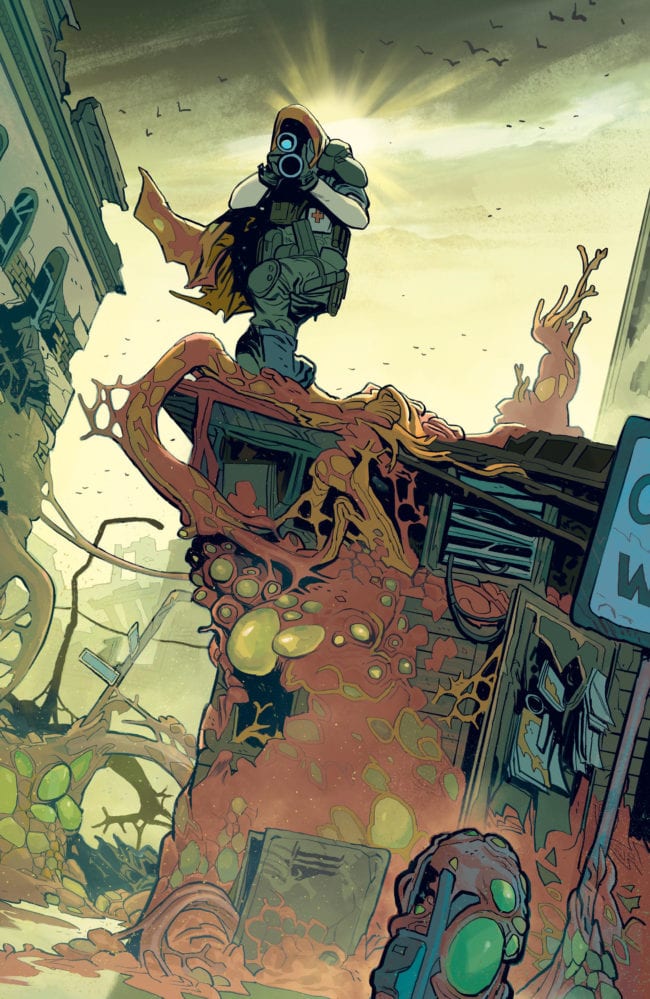A cataclysm has already taken place. Presumably hundreds of people are dead, missing, or being used for nefarious purposes. But there’s one man… a loner who isn’t duped. An outsider who’s been told by everyone—so-called experts, the needling government, his nagging girlfriend—that he needs to get a grip on reality and move on. But no. He radicalizes himself, equipped with firearms, and decides to take matters into his own white, male hands. He’s on a mission that no amount of rationality or emotional maturity can halt. This is the true story of Edgar Welch, who brought an assault rifle to the restaurant Comet Ping Pong last December to “investigate” #pizzagate on his own. It’s also the fictional story of Nathan Cole, the hero of Oblivion Song, a new Image series by Robert Kirkman and Lorenzo De Felici, that at its core is a right-wing wet dream.
But don’t worry. Nathan’s one of those “good guys with a gun.” Since the Transference, where a large portion of the population was mysteriously vanquished to a monster-laden limbo referred to as Oblivion, Nathan has found a way to strap up, hop planes of existence, and save those unfortunate souls. “Save” here is used literally and theologically, as Nathan is bringing them back from Hell to return to their families. His motives are fueled by his missing brother, who Nathan masculinly pines for in dark corner booths of dives. He used to do this with the aid of government funding, but that’s been pulled out from under him, of course. Now he’s interdimensional Dirty Harry. He drinks on his own, lives on his own (his girlfriend works for the government, so she HAD to go), and broods in a puddle of violent, dark distress on his own. He’s a real man.
 When the artist, Lorenzo De Felici, hunkers down on the beasts and finds his sweet spot in the open range of Oblivion, his contributions shine. This parallel perdition is full of mucusy fungus-covered buildings and enormous sloth-like creatures. They’re fun and kinetic and it feels like De Felici is having a blast. But much like Nathan, and presumably the baseline audience that might be attracted to this conservative reverie, he struggles when it comes to the real world. Below are three separate characters:
When the artist, Lorenzo De Felici, hunkers down on the beasts and finds his sweet spot in the open range of Oblivion, his contributions shine. This parallel perdition is full of mucusy fungus-covered buildings and enormous sloth-like creatures. They’re fun and kinetic and it feels like De Felici is having a blast. But much like Nathan, and presumably the baseline audience that might be attracted to this conservative reverie, he struggles when it comes to the real world. Below are three separate characters:
When the focus is on one virile, five-o’clock-shadowed warrior, what does it matter that all the women are strawberry blonde interchangeable cogs? There were several other queries I had—Why are both bars and science labs pitch black? Why aren’t people holding or writing anything during an important bureaucratic briefing?—and I’d be more troubled by the art, but I kept going back to the second page of the comic because it sent a shiver down my spine.
It features the main character, donning makeshift tactical gear and pointing a gun barrel straight at the reader. The sun in the background creates an angelic halo around his head. It’s been almost four weeks since 17 people were massacred in Parkland, Florida.

I’m never sure if writers like Kirkman create comics like these to appeal to their predominantly white male fan bases, or, even when given a clean slate by Image, this is literally all they can imagine. And which one of those is worse? Every criticism of this comic (and I’m sure a television show is right around the corner) will be met with defenders rallying behind the idea of "escapism." But when brutal tragedies are actually happening and not merely plot points, it shouldn’t be too much to ask writers and artists to take a step back and reflect for one goddamn minute. If your escapism does not speak to those that are oppressed, harassed, and victimized—in short, people who need escape—then something is very, potentially harmfully, wrong.
If your story panders to the dangerous “lone wolf” set, the disturbed self-made-militia buffoons, the toxic don’t-show-vulnerability-man who is all too real, then your escapism is bullshit. Your comics and ideas are irrelevant and maybe it’s time they faced their own oblivion song.











